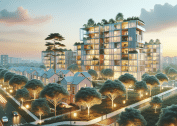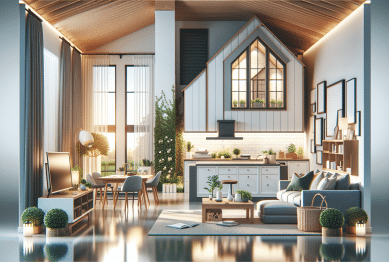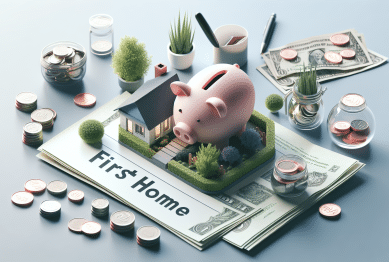Curious about what truly influences home values? Explore the unexpected and often overlooked factors in real estate that impact property worth, from location perks to neighborhood trends. Gain important insights to guide more informed decisions on buying and selling.
Understanding What Really Impacts Home Values
When discussing home values, the conversation quickly turns to square footage, bedroom count, and recent upgrades. Yet, these represent just the surface. Many important drivers shape the value of residential real estate and understanding these aspects can make a significant difference in your housing experience. The classic mantra says ‘location, location, location,’ but what does that actually mean for you as a buyer or seller in the real estate market? Not every neighborhood is created equal, and subtle elements like access to transportation, walkability, and green spaces all quietly contribute to price differences you may not realize at first glance.
While structural condition and age certainly matter, neighborhood trends often play a more significant part than initially expected. Is there new school development nearby? Is a tech hub being planned just a few blocks away? These developments can influence property worth before building even begins. Proximity to amenities, local school ratings, and community features like parks or cultural attractions have become hot keywords for buyers. Over time, small, seemingly insignificant details can lead to large disparities in home values between otherwise similar houses.
Market dynamics and historical data reveal that patterns don’t always follow intuition. For example, houses in areas with robust public transportation options or those included in urban revitalization plans may see accelerated appreciation compared to properties just a few blocks further away. Being aware of what truly drives value allows for better negotiation and a smarter approach to timing a sale or purchase. As you understand more about property value assessment, your ability to analyze the right indicators will naturally increase.
The Influence of Location Beyond ZIP Codes
Many believe a ZIP code alone predicts property value, but the reality is far more nuanced. Micro-neighborhoods within cities often vary dramatically, and factors like natural disaster risks, local business growth, and future city planning can redefine the desirability of an area. School district boundaries have particularly strong influence, frequently pushing demand (and prices) much higher for homes just inside a favored zone. Buyers and investors carefully examine these boundaries, using them as a key metric for their real estate decisions.
Access to public parks or waterfronts, crime rates, and the reputation of nearby amenities like shopping centers all play into neighborhood perception. Sometimes, an up-and-coming cultural district will quickly boost prices as art galleries or music venues move in. Conversely, proximity to noisy highways or industrial facilities can subtly reduce home values, even if homes look identical from the curb. The effect may be marginal, but in tight markets where small edges determine the final selling price, every detail counts for both buyers and sellers.
Infrastructure changes also play a substantial role. New subway stops, improved bus routes, and highway expansions are often public knowledge well before completion, causing ripple effects on nearby real estate values. Smart investors monitor local government announcements and urban planning proposals, knowing that even rumors of positive infrastructure improvements can lead to surges in property interest. For those navigating the housing market, keeping informed about these future developments acts as a valuable decision-making tool.
How Market Timing and Economic Trends Affect Values
Timing is a powerful, yet unpredictable, aspect of real estate. Home values are affected not only by local features but also by macroeconomic conditions and market sentiment. Low interest rates often lead to greater buying power and, as a result, increased demand and higher prices. Conversely, rising mortgage rates can suddenly cool off even the hottest neighborhoods, changing the trajectory for both new buyers and longtime homeowners. Staying in tune with these economic cycles allows for more strategic moves and better value retention.
Likewise, demographic patterns such as population growth, migration, and employment opportunities directly influence the demand for homes. Cities experiencing significant job creation or corporate relocations often see property prices rise, while regions dealing with population decline may face stagnant or falling values. Keeping an eye on labor market shifts and urban migration reports can provide clues about which areas might appreciate faster than others. This has become even more pronounced with the rise of remote work and shifting lifestyle priorities post-pandemic.
The role of government policies, tax incentives, and even local investment in infrastructure projects cannot be overlooked as additional layers of influence. For instance, a new public transit system or city-sponsored beautification effort can increase property values within the targeted neighborhoods. Alternatively, proposed changes in property tax laws or new zoning regulations may have the opposite effect. For homebuyers and sellers, monitoring legislative shifts and broader trends may reveal opportunities or potential pitfalls hidden underneath general market commentary.
Unique Features and Their Surprisingly Strong Impact
Certain property features unexpectedly raise home values in ways that go beyond aesthetics. Energy-efficient appliances and sustainable building materials, for example, often appeal to eco-conscious buyers and can be a deciding factor for millennials entering the market. Homes equipped with solar panels, rainwater harvesting, or modern HVAC systems may command higher sale prices and reduced time on the market. The increased popularity of green certification can differentiate a property in competitive areas.
Technology upgrades, such as smart home systems for security, lighting, or temperature control, are also drawing increased interest from tech-savvy buyers. These enhancements create perceived value and modern appeal, catering to evolving homeowner expectations. Additionally, features like open layouts, flexible living spaces, and outdoor entertainment areas have become increasingly attractive, particularly as more people balance working from home and hosting social gatherings. A simple kitchen upgrade or a landscaped yard might elevate a home far beyond neighboring properties with identical floor plans.
Accessibility and universal design are often overlooked yet powerful contributors to property value. Homes that offer barrier-free entries, wide hallways, or step-free showers appeal to a broader age range and can make a property more adaptable for families with multigenerational needs. As the population ages, features that support aging in place are projected to become essential in maximizing both property value and market appeal. Thoughtful, future-focused improvements often provide a return greater than initial investment estimates may suggest.
The Impact of Home Maintenance and Curb Appeal
Ongoing maintenance plays a critical role in shaping a property’s perceived and real value. Well-maintained homes often command higher offers, reduce negotiation friction, and provide greater confidence for buyers. Basic repairs—fresh paint, updated fixtures, and functioning systems—signal diligent ownership and can increase assessment values with minimal effort. Deferred maintenance, on the other hand, can quickly erode home equity and lead to steeper price reductions during negotiations.
Curb appeal is not just about appearances; it subtly influences first impressions and can drive up initial offers. Landscaping, exterior lighting, and an inviting entrance make a home stand out in online listings and in-person viewings. Simple projects such as painting the front door or planting seasonal flowers require little investment yet provide a measurable lift in buyer interest. Carefully maintained exteriors suggest pride of ownership, encouraging prospective buyers to further inspect interior features and upgrades.
Seasonal and market-specific styles can influence perceived value for certain buyers. For example, a backyard fire pit, an outdoor kitchen, or a home office-ready basement suite might be more valuable in certain regions or during particular seasons. Savvy sellers often tailor small enhancements to align with current preferences, boosting both visibility and perceived value without the need for major renovations. This flexibility helps properties remain competitive across evolving trends.
Neighborhood Trends and Community Vibes Matter More Than You Think
The composition and atmosphere of a neighborhood influence every aspect of real estate value. Active homeowner associations, frequent community events, and visible neighborhood pride result in a cohesive environment that feels welcoming and stable. Areas where residents regularly maintain their homes and public spaces tend to enjoy greater appreciation in property values, drawing more interested buyers into the market even during slower sales cycles.
Cultural diversity, access to fresh food markets, dog parks, and community gardens add a unique flavor that attracts buyers seeking lifestyle upgrades as part of their housing search. Community initiatives, such as local farmer’s markets or volunteer events, foster a sense of belonging that can directly—or indirectly—affect property price resilience. Additionally, knowing that a neighborhood is steadily attracting young families or professionals seeking long-term roots may inspire more investment from current owners in both upkeep and improvements.
Digital connectivity to neighborhood groups or social media communities has become another critical factor in shaping local real estate buzz. A vibrant online community can help new residents easily integrate, find local services, and stay informed on area happenings. This sense of virtual connection can solidify a neighborhood’s reputation, attracting continuous interest and contributing to the ongoing stability of home values within the region.
References
1. National Association of Realtors. (n.d.). Location, Location, Location. Retrieved from https://www.nar.realtor/location-location-location
2. U.S. Department of Housing and Urban Development. (n.d.). How Infrastructure Investments Can Improve Housing Markets. Retrieved from https://www.huduser.gov/portal/pdredge/pdr-edge-trending-04092018.html
3. Federal Reserve Bank of St. Louis. (n.d.). Economic Factors Affecting Home Prices. Retrieved from https://www.stlouisfed.org/on-the-economy/2019/aug/economic-factors-affecting-home-prices
4. Appraisal Institute. (n.d.). The Importance of Curb Appeal in Real Estate. Retrieved from https://www.appraisalinstitute.org/the-importance-of-curb-appeal-in-valuing-homes/
5. Urban Land Institute. (n.d.). Housing Trends and Neighborhood Change. Retrieved from https://uli.org/research/centers-initiatives/terwilliger-center-for-housing/housing-trends-and-neighborhood-change/
6. Harvard Joint Center for Housing Studies. (n.d.). The Value of Home Improvements. Retrieved from https://www.jchs.harvard.edu/blog/the-value-of-home-improvements









